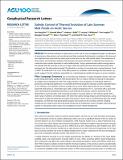Files in this item
Salinity control of thermal evolution of late summer melt ponds on Arctic sea ice
Item metadata
| dc.contributor.author | Kim, Joo Hong | |
| dc.contributor.author | Moon, Woosok | |
| dc.contributor.author | Wells, Andrew J. | |
| dc.contributor.author | Wilkinson, Jeremy P. | |
| dc.contributor.author | Langton, Tom | |
| dc.contributor.author | Hwang, Byongjun | |
| dc.contributor.author | Granskog, Mats A. | |
| dc.contributor.author | Rees Jones, David W. | |
| dc.date.accessioned | 2019-07-03T14:30:07Z | |
| dc.date.available | 2019-07-03T14:30:07Z | |
| dc.date.issued | 2018-08-28 | |
| dc.identifier | 259433580 | |
| dc.identifier | 1a4f9b2b-01fc-4929-a059-1c89cdb4186d | |
| dc.identifier | 85053184820 | |
| dc.identifier.citation | Kim , J H , Moon , W , Wells , A J , Wilkinson , J P , Langton , T , Hwang , B , Granskog , M A & Rees Jones , D W 2018 , ' Salinity control of thermal evolution of late summer melt ponds on Arctic sea ice ' , Geophysical Research Letters , vol. 45 , no. 16 , pp. 8304-8313 . https://doi.org/10.1029/2018GL078077 | en |
| dc.identifier.issn | 0094-8276 | |
| dc.identifier.other | ORCID: /0000-0001-8698-401X/work/59222353 | |
| dc.identifier.uri | https://hdl.handle.net/10023/18036 | |
| dc.description | Funding: A.J.W. and D.R.J. acknowledge support from the John Fell Oxford University Press Research Fund and thank the Isaac Newton Institute for Mathematical Sciences for hospitality (EPSRC Grant EP/K032208/1). | en |
| dc.description.abstract | The thermal evolution of melt ponds on Arctic sea ice was investigated through a combination of autonomous observations and two-dimensional high-resolution fluid dynamics simulations. We observed one relatively fresh pond and one saline pond on the same ice floe, with similar depth. The comparison of observations and simulations indicates that thermal convection dominates in relatively fresh ponds, but conductive heat transfer dominates in salt-stratified ponds. Using a parameterized surface energy balance, we estimate that the heat flux to the ice is larger under the saline pond than the freshwater pond when averaged over the observational period. The deviation is sensitive to assumed wind, varying between 3 and 14 W/m2 for winds from 0 to 5 m/s. If this effect persists as conditions evolve through the melt season, our results suggest that this imbalance potentially has a climatologically significant impact on sea-ice evolution. | |
| dc.format.extent | 10 | |
| dc.format.extent | 1622467 | |
| dc.language.iso | eng | |
| dc.relation.ispartof | Geophysical Research Letters | en |
| dc.subject | 2-D melt pond model | en |
| dc.subject | Arctic sea ice | en |
| dc.subject | Heat flux | en |
| dc.subject | Ice mass balance buoy | en |
| dc.subject | Melt ponds | en |
| dc.subject | Salinity of melt ponds | en |
| dc.subject | QA Mathematics | en |
| dc.subject | QE Geology | en |
| dc.subject | Earth and Planetary Sciences(all) | en |
| dc.subject | Geophysics | en |
| dc.subject | DAS | en |
| dc.subject.lcc | QA | en |
| dc.subject.lcc | QE | en |
| dc.title | Salinity control of thermal evolution of late summer melt ponds on Arctic sea ice | en |
| dc.type | Journal article | en |
| dc.contributor.institution | University of St Andrews. Applied Mathematics | en |
| dc.identifier.doi | https://doi.org/10.1029/2018GL078077 | |
| dc.description.status | Peer reviewed | en |
| dc.date.embargoedUntil | 2019-02-21 | |
| dc.identifier.url | https://ora.ox.ac.uk/objects/pubs:891714 | en |
This item appears in the following Collection(s)
Items in the St Andrews Research Repository are protected by copyright, with all rights reserved, unless otherwise indicated.

